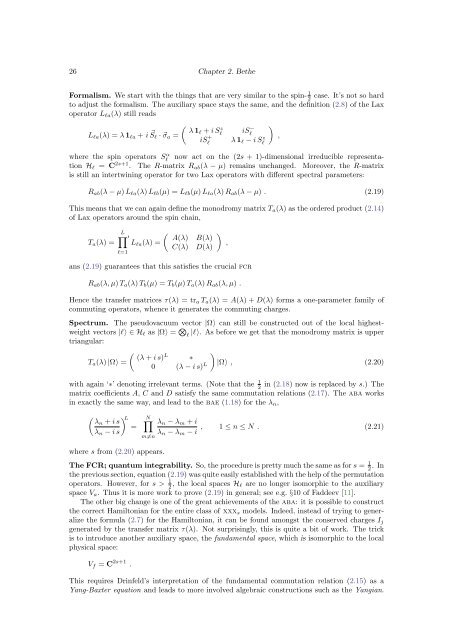The Bethe/Gauge Correspondence
The Bethe/Gauge Correspondence
The Bethe/Gauge Correspondence
You also want an ePaper? Increase the reach of your titles
YUMPU automatically turns print PDFs into web optimized ePapers that Google loves.
26 Chapter 2. <strong>Bethe</strong>Formalism. We start with the things that are very similar to the spin- 1 2case. It’s not so hardto adjust the formalism. <strong>The</strong> auxiliary space stays the same, and the definition (2.8) of the Laxoperator L la (λ) still reads(L la (λ) = λ 1 la + i S ⃗ λ 1l + i Sl · ⃗σ a =l z iS − )liS + lλ 1 l − i Slz ,where the spin operators Slα now act on the (2s + 1)-dimensional irreducible representationH l = C 2s+1 . <strong>The</strong> R-matrix R ab (λ − µ) remains unchanged. Moreover, the R-matrixis still an intertwining operator for two Lax operators with different spectral parameters:R ab (λ − µ) L la (λ) L lb (µ) = L lb (µ) L la (λ) R ab (λ − µ) . (2.19)This means that we can again define the monodromy matrix T a (λ) as the ordered product (2.14)of Lax operators around the spin chain,T a (λ) =L∏ ′l=1(A(λ) B(λ)L la (λ) =C(λ) D(λ)),ans (2.19) guarantees that this satisfies the crucial fcrR ab (λ, µ) T a (λ) T b (µ) = T b (µ) T a (λ) R ab (λ, µ) .Hence the transfer matrices τ(λ) = tr a T a (λ) = A(λ) + D(λ) forms a one-parameter family ofcommuting operators, whence it generates the commuting charges.Spectrum. <strong>The</strong> pseudovacuum vector |Ω〉 can still be constructed out of the local highestweightvectors |l〉 ∈ H l as |Ω〉 = ⊗ l|l〉. As before we get that the monodromy matrix is uppertriangular:( )(λ + i s)L∗T a (λ) |Ω〉 =0 (λ − i s) L |Ω〉 , (2.20)with again ‘∗’ denoting irrelevant terms. (Note that the 1 2in (2.18) now is replaced by s.) <strong>The</strong>matrix coefficients A, C and D satisfy the same commutation relations (2.17). <strong>The</strong> aba worksin exactly the same way, and lead to the bae (1.18) for the λ n ,( ) L λn + i s=λ n − i sN∏m≠nλ n − λ m + iλ n − λ m − i , 1 ≤ n ≤ N . (2.21)where s from (2.20) appears.<strong>The</strong> FCR; quantum integrability. So, the procedure is pretty much the same as for s = 1 2 . Inthe previous section, equation (2.19) was quite easily established with the help of the permutationoperators. However, for s > 1 2 , the local spaces H l are no longer isomorphic to the auxiliaryspace V a . Thus it is more work to prove (2.19) in general; see e.g. §10 of Faddeev [11].<strong>The</strong> other big change is one of the great achievements of the aba: it is possible to constructthe correct Hamiltonian for the entire class of xxx s models. Indeed, instead of trying to generalizethe formula (2.7) for the Hamiltonian, it can be found amongst the conserved charges I jgenerated by the transfer matrix τ(λ). Not surprisingly, this is quite a bit of work. <strong>The</strong> trickis to introduce another auxiliary space, the fundamental space, which is isomorphic to the localphysical space:V f = C 2s+1 .This requires Drinfeld’s interpretation of the fundamental commutation relation (2.15) as aYang-Baxter equation and leads to more involved algebraic constructions such as the Yangian.
















